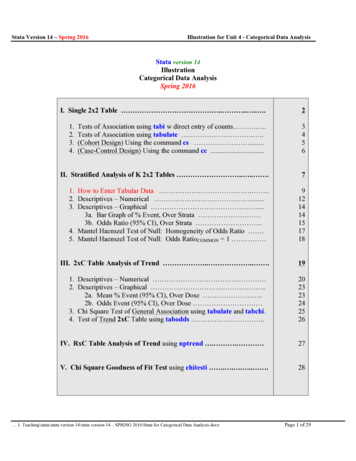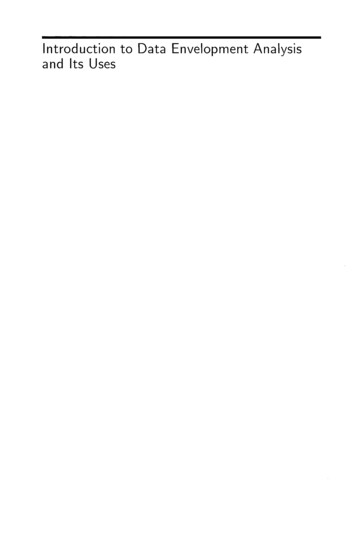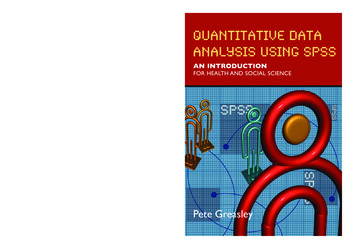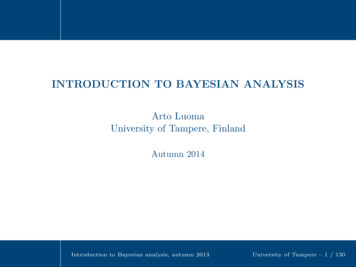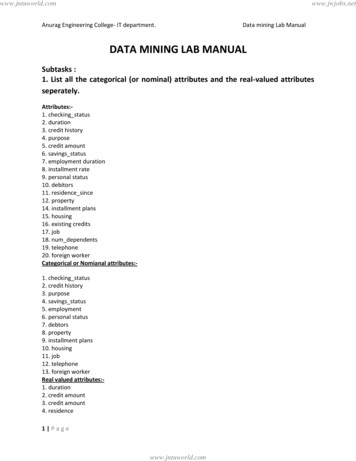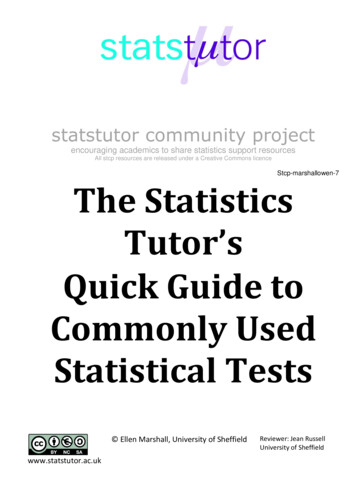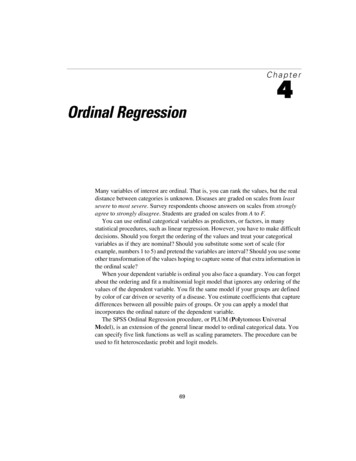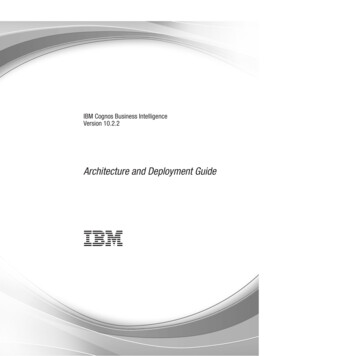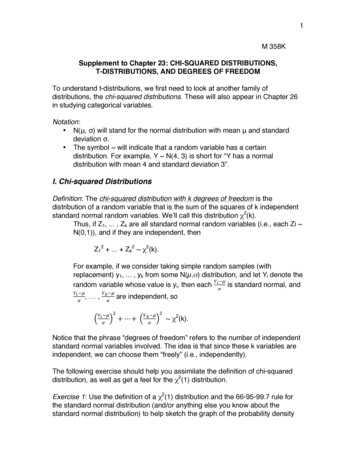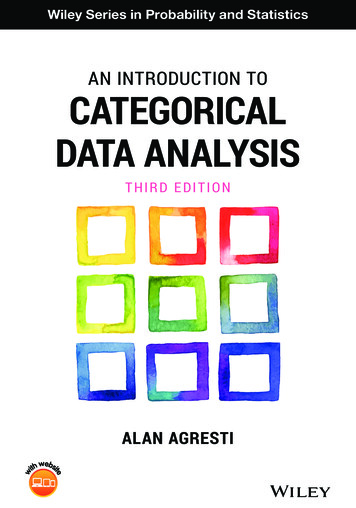
Transcription
Wiley Series in Probability and StatisticsAN INTRODUCTION TOCATEGORICALDATA ANALYSISTHIRD EDITIONALAN AGRESTI
AN INTRODUCTION TOCATEGORICAL DATA ANALYSIS
WILEY SERIES IN PROBABILITY AND STATISTICSEstablished by Walter A. Shewhart and Samuel S. WilksEditors: David J. Balding, Noel A. C. Cressie, Garrett M. Fitzmaurice,Geof H. Givens, Harvey Goldstein, Geert Molenberghs, David W. Scott,Adrian F. M. Smith, Ruey S. TsayEditors Emeriti: J. Stuart Hunter, Iain M. Johnstone, Joseph B. Kadane,Jozef L. TeugelsThe Wiley Series in Probability and Statistics is well established andauthoritative. It covers many topics of current research interest in bothpure and applied statistics and probability theory. Written by leadingstatisticians and institutions, the titles span both state-of-the-artdevelopments in the field and classical methods.Reflecting the wide range of current research in statistics, the seriesencompasses applied, methodological and theoretical statistics, rangingfrom applications and new techniques made possible by advances incomputerized practice to rigorous treatment of theoretical approaches.This series provides essential and invaluable reading for all statisticians,whether in academia, industry, government, or research.A complete list of titles in this series can be found athttp://www.wiley.com/go/wsps
AN INTRODUCTION TOCATEGORICAL DATAANALYSISThird EditionAlan AgrestiUniversity of Florida, Florida, United States
This third edition first published 2019 2019 John Wiley & Sons, Inc.Edition History(1e, 1996); John Wiley & Sons, Inc. (2e, 2007); John Wiley & Sons, Inc.All rights reserved. No part of this publication may be reproduced, stored in a retrieval system, or transmitted, inany form or by any means, electronic, mechanical, photocopying, recording or otherwise, except as permitted bylaw. Advice on how to obtain permission to reuse material from this title is available athttp://www.wiley.com/go/permissions.The right of Alan Agresti to be identified as the author of this work has been asserted in accordance with law.Registered OfficeJohn Wiley & Sons, Inc., 111 River Street, Hoboken, NJ 07030, USAEditorial Office111 River Street, Hoboken, NJ 07030, USAFor details of our global editorial offices, customer services, and more information about Wiley products visit usat www.wiley.com.Wiley also publishes its books in a variety of electronic formats and by print-on-demand. Some content thatappears in standard print versions of this book may not be available in other formats.Limit of Liability/Disclaimer of WarrantyWhile the publisher and authors have used their best efforts in preparing this work, they make no representationsor warranties with respect to the accuracy or completeness of the contents of this work and specifically disclaimall warranties, including without limitation any implied warranties of merchantability or fitness for a particularpurpose. No warranty may be created or extended by sales representatives, written sales materials or promotionalstatements for this work. The fact that an organization, website, or product is referred to in this work as a citationand/or potential source of further information does not mean that the publisher and authors endorse theinformation or services the organization, website, or product may provide or recommendations it may make. Thiswork is sold with the understanding that the publisher is not engaged in rendering professional services. Theadvice and strategies contained herein may not be suitable for your situation. You should consult with a specialistwhere appropriate. Further, readers should be aware that websites listed in this work may have changed ordisappeared between when this work was written and when it is read. Neither the publisher nor authors shall beliable for any loss of profit or any other commercial damages, including but not limited to special, incidental,consequential, or other damages.Library of Congress Cataloging-in-Publication DataNames: Agresti, Alan, author.Title: An introduction to categorical data analysis / Alan Agresti.Description: Third edition. Hoboken, NJ : John Wiley & Sons, 2019. Series: Wiley series in probability andstatistics Includes bibliographical references and index. Identifiers: LCCN 2018026887 (print) LCCN 2018036674 (ebook) ISBN 9781119405276 (Adobe PDF) ISBN 9781119405283 (ePub) ISBN 9781119405269 (hardcover)Subjects: LCSH: Multivariate analysis.Classification: LCC QA278 (ebook) LCC QA278 .A355 2019 (print) DDC 519.5/35–dc23LC record available at https://lccn.loc.gov/2018026887Cover Design: WileyCover Image: iStock.com/Anna ZubkovaSet in 10/12.5pt Nimbus by Aptara Inc., New Delhi, IndiaPrinted in the United States of America10 9 8 7 6 5 4 3 2 1
CONTENTSPrefaceixAbout the Companion Website12Introductionxiii11.1 Categorical Response Data1.2 Probability Distributions for Categorical Data1.3 Statistical Inference for a Proportion1.4 Statistical Inference for Discrete Data1.5 Bayesian Inference for Proportions *1.6 Using R Software for Statistical Inference about Proportions *Exercises13510131721Analyzing Contingency bility Structure for Contingency TablesComparing Proportions in 2 2 Contingency TablesThe Odds RatioChi-Squared Tests of IndependenceTesting Independence for Ordinal VariablesExact Frequentist and Bayesian Inference *Association in Three-Way TablesExercisesv
viCONTENTS3 Generalized Linear Models3.13.23.33.43.5Components of a Generalized Linear ModelGeneralized Linear Models for Binary DataGeneralized Linear Models for Counts and RatesStatistical Inference and Model CheckingFitting Generalized Linear ModelsExercises4 Logistic Regression4.14.24.34.44.54.6The Logistic Regression ModelStatistical Inference for Logistic RegressionLogistic Regression with Categorical PredictorsMultiple Logistic RegressionSummarizing Effects in Logistic RegressionSummarizing Predictive Power: Classification Tables, ROC Curves, andMultiple CorrelationExercises5 Building and Applying Logistic Regression Models5.15.25.35.4Strategies in Model SelectionModel CheckingInfinite Estimates in Logistic RegressionBayesian Inference, Penalized Likelihood, and Conditional Likelihoodfor Logistic Regression *5.5 Alternative Link Functions: Linear Probability andProbit Models *5.6 Sample Size and Power for Logistic Regression *Exercises6 Multicategory Logit Models6.16.26.36.4Baseline-Category Logit Models for Nominal ResponsesCumulative Logit Models for Ordinal ResponsesCumulative Link Models: Model Checking and Extensions *Paired-Category Logit Modeling of Ordinal Responses *Exercises7 Loglinear Models for Contingency Tables and Counts7.1 Loglinear Models for Counts in Contingency Tables7.2 Statistical Inference for Loglinear Models7.3 The Loglinear – Logistic Model 130136140145150151159159167176184187193194200207
CONTENTS7.47.57.689Independence Graphs and CollapsibilityModeling Ordinal Associations in Contingency TablesLoglinear Modeling of Count Response Variables *Exercises11210214217221Models for Matched Pairs2278.1 Comparing Dependent Proportions for Binary Matched Pairs8.2 Marginal Models and Subject-Specific Models for Matched Pairs8.3 Comparing Proportions for Nominal Matched-Pairs Responses8.4 Comparing Proportions for Ordinal Matched-Pairs Responses8.5 Analyzing Rater Agreement *8.6 Bradley–Terry Model for Paired Preferences *Exercises228230235239243247249Marginal Modeling of Correlated, Clustered Responses2539.19.2254Marginal Models Versus Subject-Specific ModelsMarginal Modeling: The Generalized Estimating Equations (GEE)Approach9.3 Marginal Modeling for Clustered Multinomial Responses9.4 Transitional Modeling, Given the Past9.5 Dealing with Missing Data *Exercises10vii255260263266268Random Effects: Generalized Linear Mixed Models27310.1 Random Effects Modeling of Clustered Categorical Data10.2 Examples: Random Effects Models for Binary Data10.3 Extensions to Multinomial Responses and Multiple Random EffectTerms10.4 Multilevel (Hierarchical) Models10.5 Latent Class Models *Exercises273278284288291295Classification and Smoothing *29911.1 Classification: Linear Discriminant Analysis11.2 Classification: Tree-Based Prediction11.3 Cluster Analysis for Categorical Responses11.4 Smoothing: Generalized Additive Models11.5 Regularization for High-Dimensional Categorical Data (Large p)Exercises300302306310313321
viii12CONTENTSA Historical Tour of Categorical Data Analysis *Appendix: Software for Categorical Data AnalysisA.1A.2A.3A.4R for Categorical Data AnalysisSAS for Categorical Data AnalysisStata for Categorical Data AnalysisSPSS for Categorical Data Analysis325331331332342346Brief Solutions to Odd-Numbered Exercises349Bibliography363Examples Index365Subject Index369
PREFACEIn recent years, the use of specialized statistical methods for categorical data has increaseddramatically, particularly for applications in the biomedical and social sciences. Partly thisreflects the development during the past few decades of sophisticated methods for analyzingcategorical data. It also reflects the increasing methodological sophistication of scientistsand applied statisticians, most of whom now realize that it is unnecessary and ofteninappropriate to use methods for continuous data with categorical responses.This third edition of the book is a substantial revision of the second edition. The mostimportant change is showing how to conduct all the analyses using R software. As in thefirst two editions, the main focus is presenting the most important methods for analyzingcategorical data. The book summarizes methods that have long played a prominent role,such as chi-squared tests, but gives special emphasis to modeling techniques, in particularto logistic regression.The presentation in this book has a low technical level and does not require familiaritywith advanced mathematics such as calculus or matrix algebra. Readers should possess abackground that includes material from a two-semester statistical methods sequence forundergraduate or graduate nonstatistics majors. This background should include estimationand significance testing and exposure to regression modeling.This book is designed for students taking an introductory course in categorical dataanalysis, but I also have written it for applied statisticians and practicing scientists involvedin data analyses. I hope that the book will be helpful to analysts dealing with categoricalresponse data in the social, behavioral, and biomedical sciences, as well as in public health,marketing, education, biological and agricultural sciences, and industrial quality control.The basics of categorical data analysis are covered in Chapters 1 to 7. Chapter 2 surveysstandard descriptive and inferential methods for contingency tables, such as odds ratios, testsix
xPREFACEof independence, and conditional versus marginal associations. I feel that an understandingof methods is enhanced, however, by viewing them in the context of statistical models. Thus,the rest of the text focuses on the modeling of categorical responses. I prefer to teach categorical data methods by unifying their models with ordinary regression models. Chapter 3 doesthis under the umbrella of generalized linear models. That chapter introduces generalizedlinear models for binary data and count data. Chapters 4 and 5 discuss the most important such model for binary data, logistic regression. Chapter 6 introduces logistic regressionmodels for multicategory responses, both nominal and ordinal. Chapter 7 discusses loglinearmodels for contingency tables and other types of count data.I believe that logistic regression models deserve more attention than loglinear models, because applications more commonly focus on the relationship between a categoricalresponse variable and some explanatory variables (which logistic regression models do)than on the association structure among several response variables (which loglinear modelsdo). Thus, I have given main attention to logistic regression in these chapters and in laterchapters that discuss extensions of this model.Chapter 8 presents methods for matched-pairs data. Chapters 9 and 10 extend thematched-pairs methods to apply to clustered, correlated observations. Chapter 9 does thiswith marginal models, emphasizing the generalized estimating equations (GEE) approach,whereas Chapter 10 uses random effects to model more fully the dependence. Chapter 11is a new chapter, presenting classification and smoothing methods. That chapter also introduces regularization methods that are increasingly important with the advent of data setshaving large numbers of explanatory variables. Chapter 12 provides a historical perspectiveof the development of the methods. The text concludes with an appendix showing the useof R, SAS, Stata, and SPSS software for conducting nearly all methods presented in thisbook. Many of the chapters now also show how to use the Bayesian approach to conductthe analyses.The material in Chapters 1 to 7 forms the heart of an introductory course in categoricaldata analysis. Sections that can be skipped if desired, to provide more time for other topics,include Sections 1.5, 2.5–2.7, 3.3 and 3.5, 5.4–5.6, 6.3–6.4, and 7.4–7.6. Instructors canchoose sections from Chapters 8 to 12 to supplement the topics of primary importance.Sections and subsections labeled with an asterisk can be skipped for those wanting a briefersurvey of the methods.This book has lower technical level than my book Categorical Data Analysis (3rd edition,Wiley 2013). I hope that it will appeal to readers who prefer a more applied focus than thatbook provides. For instance, this book does not attempt to derive likelihood equations, proveasymptotic distributions, or cite current research work.Most methods for categorical data analysis require extensive computations. For the mostpart, I have avoided details about complex calculations, feeling that statistical softwareshould relieve this drudgery. The text shows how to use R to obtain all the analyses presented.The Appendix discusses the use of SAS, Stata, and SPSS. The full data sets analyzed in thebook are available at the text website www.stat.ufl.edu/ aa/cat/data. That websitealso lists typos and errors of which I have become aware since publication. The data filesare also available at ief solutions to odd-numbered exercises appear at the end of the text. An instructor’s manual will be included on the companion website for this edition: www.wiley.com/go/Agresti/CDA 3e. The aforementioned data sets will also be available on thecompanion website. Additional exercises are available there and at www.stat.ufl.edu/
PREFACExi aa/cat/Extra Exercises, some taken from the 2nd edition to create space for newmaterial in this edition and some being slightly more technical.I owe very special thanks to Brian Marx for his many suggestions about the text overthe past twenty years. He has been incredibly generous with his time in providing feedbackbased on teaching courses based on the book. I also thank those individuals who commentedon parts of the manuscript or who made suggestions about examples or material to coveror provided other help such as noticing errors. Travis Gerke, Anna Gottard, and KeramatNourijelyani gave me several helpful comments. Thanks also to Alessandra Brazzale, Debora Giovannelli, David Groggel, Stacey Handcock, Maria Kateri, Bernhard Klingenberg,Ioannis Kosmidis, Mohammad Mansournia, Trevelyan McKinley, Changsoon Park, TomPiazza, Brett Presnell, Ori Rosen, Ralph Scherer, Claudia Tarantola, Anestis Touloumis,Thomas Yee, Jin Wang, and Sherry Wang. I also owe thanks to those who helped with thefirst two editions, especially Patricia Altham, James Booth, Jane Brockmann, Brian Caffo,Brent Coull, Al DeMaris, Anna Gottard, Harry Khamis, Svend Kreiner, Carla Rampichini,Stephen Stigler, and Larry Winner. Thanks to those who helped with material for mymore advanced text (Categorical Data Analysis) that I extracted here, especially BernhardKlingenberg, Yongyi Min, and Brian Caffo. Many thanks also to the staff at Wiley for theirusual high-quality help.A truly special by-product for me of writing books about categorical data analysis hasbeen invitations to teach short courses based on them and spend research visits at manyinstitutions around the world. With grateful thanks I dedicate this book to my hosts overthe years. In particular, I thank my hosts in Italy (Adelchi Azzalini, Elena Beccalli, RinoBellocco, Matilde Bini, Giovanna Boccuzzo, Alessandra Brazzale, Silvia Cagnone,Paula Cerchiello, Andrea Cerioli, Monica Chiogna, Guido Consonni, Adriano Decarli,Mauro Gasparini, Alessandra Giovagnoli, Sabrina Giordano, Paolo Giudici, AnnaGottard, Alessandra Guglielmi, Maria Iannario, Gianfranco Lovison, Claudio Lupi, MoniaLupparelli, Maura Mezzetti, Antonietta Mira, Roberta Paroli, Domenico Piccolo, IrenePoli, Alessandra Salvan, Nicola Sartori, Bruno Scarpa, Elena Stanghellini, ClaudiaTarantola, Cristiano Varin, Roberta Varriale, Laura Ventura, Diego Zappa), the UK (PhilBrown, Bianca De Stavola, Brian Francis, Byron Jones, Gillian Lancaster, Irini Moustaki,Chris Skinner, Briony Teather), Austria (Regina Dittrich, Gilg Seeber, Helga Wagner),Belgium (Hermann Callaert, Geert Molenberghs), France (Antoine De Falguerolles,Jean-Yves Mary, Agnes Rogel), Germany (Maria Kateri, Gerhard Tutz), Greece (MariaKateri, Ioannis Ntzoufras), the Netherlands (Ivo Molenaar, Marijte van Duijn, Peter vander Heijden), Norway (Petter Laake), Portugal (Francisco Carvalho, Adelaide Freitas,Pedro Oliveira, Carlos Daniel Paulino), Slovenia (Janez Stare), Spain (Elias Moreno),Sweden (Juni Palmgren, Elisabeth Svensson, Dietrich van Rosen), Switzerland (AnthonyDavison, Paul Embrechts), Brazil (Clarice Demetrio, Bent Jörgensen, Francisco Louzada,Denise Santos), Chile (Guido Del Pino), Colombia (Marta Lucia Corrales Bossio, LeonardoTrujillo), Turkey (Aylin Alin), Mexico (Guillermina Eslava), Australia (Chris Lloyd), China(I-Ming Liu, Chongqi Zhang), Japan (Ritei Shibata), and New Zealand (Nye John, I-MingLiu). Finally, thanks to my wife, Jacki Levine, for putting up with my travel schedule inthese visits around the world!ALAN AGRESTIGainesville, Florida and Brookline, MassachusettsMarch 2018
ABOUT THE COMPANION WEBSITEThis book comes with a companion website of other material, including all data sets analyzed in the book and some extra exercises.www.wiley.com/go/Agresti/CDA 3exiii
CHAPTER 1INTRODUCTIONFrom helping to assess the value of new medical treatments to evaluating the factors thataffect our opinions on controversial issues, scientists today are finding myriad uses for categorical data analyses. It is primarily for these scientists and their collaborating statisticians –as well as those training to perform these roles – that this book was written.This first chapter reviews the most important probability distributions for categoricaldata: the binomial and multinomial distributions. It also introduces maximum likelihood, themost popular method for using data to estimate parameters. We use this type of estimate anda related likelihood function to conduct statistical inference. We also introduce the Bayesianapproach to statistical inference, which utilizes probability distributions for the parametersas well as for the data. We begin by describing the major types of categorical data.1.1 CATEGORICAL RESPONSE DATAA categorical variable has a measurement scale consisting of a set of categories. For example, political ideology might be measured as liberal, moderate, or conservative; choice ofaccommodation might use categories house, condominium, and apartment; a diagnostic testto detect e-mail spam might classify an incoming e-mail message as spam or legitimate. Categorical variables are often referred to as qualitative, to distinguish them from quantitativevariables, which take numerical values, such as age, income, and number of children in afamily.An Introduction to Categorical Data Analysis, Third Edition. Alan Agresti. 2019 John Wiley & Sons, Inc. Published 2019 by John Wiley & Sons, Inc.Companion Website: www.wiley.com/go/Agresti/CDA 3e1
21. INTRODUCTIONCategorical variables are pervasive in the social sciences for measuring attitudes andopinions, with categories such as (agree, disagree), (yes, no), and (favor, oppose, undecided). They also occur frequently in the health sciences, for measuring responses such aswhether a medical treatment is successful (yes, no), mammogram-based breast diagnosis(normal, benign, probably benign, suspicious, malignant with cancer), and stage of a disease (initial, intermediate, advanced). Categorical variables are common for service-qualityratings of any company or organization that has customers (e.g., with categories excellent,good, fair, poor). In fact, categorical variables occur frequently in most disciplines. Otherexamples include the behavioral sciences (e.g., diagnosis of type of mental illness, withcategories schizophrenia, depression, neurosis), ecology (e.g., primary land use in satelliteimage, with categories woodland, swamp, grassland, agriculture, urban), education (e.g.,student responses to an exam question, with categories correct, incorrect), and marketing(e.g., consumer cell-phone preference, with categories Samsung, Apple, Nokia, LG, Other).They even occur in highly quantitative fields such as the engineering sciences and industrial quality control, when items are classified according to whether or not they conform tocertain standards.1.1.1 Response Variable and Explanatory VariablesMost statistical analyses distinguish between a response variable and explanatory variables.For instance, ordinary regression models describe how the mean of a quantitative responsevariable, such as annual income, changes according to levels of explanatory variables, suchas number of years of education and number of years of job experience. The response variable is sometimes called the dependent variable and the explanatory variable is sometimescalled the independent variable. When we want to emphasize that the response variableis a random variable, such as in a probability statement, we use upper-case notation for it(e.g., Y ). We use lower-case notation to refer to a particular value (e.g., y 0).This text presents statistical models that relate a categorical response variable to explanatory variables that can be categorical or quantitative. For example, a study might analyzehow opinion about whether same-sex marriage should be legal (yes or no) is associated withexplanatory variables such as number of years of education, annual income, political partyaffiliation, religious affiliation, age, gender, and race.1.1.2 Binary–Nominal–Ordinal Scale DistinctionMany categorical variables have only two categories, such as (yes, no) for possessing healthinsurance or (favor, oppose) for legalization of marijuana. Such variables are called binaryvariables.When a categorical variable has more then two categories, we distinguish between twotypes of categorical scales. Categorical variables having unordered scales are called nominal variables. Examples are religious affiliation (categories Christian, Jewish, Muslim,Buddhist, Hindu, none, other), primary mode of transportation to work (automobile, bicycle, bus, subway, walk), and favorite type of music (classical, country, folk, jazz, pop, rock).Variables having naturally ordered categories are called ordinal variables. Examples areperceived happiness (not too happy, pretty happy, very happy), frequency of feeling anxiety(never, occasionally, often, always), and headache pain (none, slight, moderate, severe).
1.2 PROBABILITY DISTRIBUTIONS FOR CATEGORICAL DATA3A variable’s measurement scale determines which statistical methods are appropriate.For nominal variables, the order of listing the categories is arbitrary, so methods designedfor them give the same results no matter what order is used. Methods designed for ordinalvariables utilize the category ordering.1.1.3 Organization of this BookChapters 1 and 2 describe basic non model-based methods of categorical data analysis.These include analyses of proportions and of association between categorical variables.Chapters 3 to 7 introduce models for categorical response variables. These models resemble regression models for quantitative response variables. In fact, Chapter 3 shows they arespecial cases of a class of generalized linear models that also contains the ordinary normaldistribution-based regression models. Logistic regression models, which apply to binaryresponse variables, are the focus of Chapters 4 and 5. Chapter 6 extends logistic regression to multicategory responses, both nominal and ordinal. Chapter 7 introduces loglinearmodels, which analyze associations among multiple categorical response variables.The methods in Chapters 1 to 7 assume that observations are independent. Chapters 8to 10 introduce logistic regression models for observations that are correlated, such as formatched pairs or for repeated measurement of individuals in longitudinal studies. Chapter 11introduces some advanced methods, including ways of classifying and clustering observations into categories and ways of dealing with data sets having huge numbers of variables.The book concludes (Chapter 12) with a historical overview of the development of categorical data methods.Statistical software packages can implement methods for categorical data analysis. Weillustrate throughout the text for the free software R. The Appendix discusses the use of SAS,Stata, and SPSS. A companion website for the book, www.stat.ufl.edu/ aa/cat, hasadditional information, including complete data sets for the examples. The data files arealso available at 2 PROBABILITY DISTRIBUTIONS FOR CATEGORICAL DATAParametric inferential statistical analyses require an assumption about the probability distribution of the response variable. For regression models for quantitative variables, the normaldistribution plays a central role. This section presents the key probability distributions forcategorical variables: the binomial and multinomial distributions.1.2.1 Binomial DistributionWhen the response variable is binary, we refer to the two outcome categories as success andfailure. These labels are generic and the success outcome need not be a preferred result.Many applications refer to a fixed number n of independent and identical trials withtwo possible outcomes for each. Identical trials means that the probability of success isthe same for each trial. Independent trials means the response outcomes are independentrandom variables. In particular, the outcome of one trial does not affect the outcome ofanother. These are often called Bernoulli trials. Let π denote the probability of success for
41. INTRODUCTIONeach trial. Let Y denote the number of successes out of the n trials. Under the assumption ofn independent, identical trials, Y has the binomial distribution with index n and parameterπ. The probability of a particular outcome y for Y equalsP (y) n!π y (1 π)n y ,y!(n y)!y 0, 1, 2, . . . , n.(1.1)To illustrate, suppose a quiz has ten multiple-choice questions, with five possible answersfor each. A student who is completely unprepared randomly guesses the answer for eachquestion. Let Y denote the number of correct responses. For each question, the probabilityof a correct response is 0.20, so π 0.20 with n 10. The probability of y 0 correctresponses, and hence n y 10 incorrect ones, equalsP (0) 10!(0.20)0 (0.80)10 (0.80)10 0.107.0!10!The probability of 1 correct response equalsP (1) 10!(0.20)1 (0.80)9 10(0.20)(0.80)9 0.268.1!9!Table 1.1 shows the binomial distribution for all the possible values, y 0, 1, 2, . . . , 10.For contrast, it also shows the binomial distributions when π 0.50 and when π 0.80.Table 1.1 Binomial distributions with n 10 and π 0.20, 0.50, and 0.80. The binomialdistribution is symmetric when π 0.50.yP(y) when π 0.20(μ 2.0, σ 1.26)P(y) when π 0.50(μ 5.0, σ 1.58)P(y) when π 0.80(μ 8.0, σ 050.0270.0880.2010.3020.2680.107The binomial distribution for n trials with parameter π has mean and standard deviationE(Y ) μ nπ, σ nπ(1 π).The binomial distributionwith π 0.20 in Table 1.1 has μ 10(0.20) 2.0. The standard deviation is σ 10(0.20)(0.80) 1.26, which σ also equals when π 0.80.The binomial distribution is symmetric when π 0.50. For fixed n, it becomes morebell-shaped as π gets closer to 0.50. For fixed π, it becomes more bell-shaped as n increases.
1.3 STATISTICAL INFERENCE FOR A PROPORTION5When n is large, it can be approximated by a normal distribution with μ nπ and σ nπ(1 π). A guideline1 is that the expected number of outcomes of the two types, nπand n(1 π), should both be at least about 5. For π 0.50 this requires only n 10,whereas π 0.10 (or π 0.90) requires n 50. When π gets nearer to 0 or 1, largersamples are needed before a symmetric, bell shape occurs.1.2.2 Multinomial DistributionNominal and ordinal response variables have more than two possible outcomes. When theobservations are independent with the same category probabilities for each, the probabilitydistribution of counts in the outcome categories is the multinomial.Let c denote the numberof outcome categories. We denote their probabilities by (π1 , π2 , . . . , πc ), where j πj 1. For n independent observations, the multinomial probability that y1 fall in category 1, y2 fall in category 2, . , yc fall in category c, where j yj n, equals P (y1 , y2 , ., yc ) n!y1 !y2 ! · · · yc ! π1y1 π2y2 · · · πcyc .T
response data in the social, behavioral, and biomedical sciences, as well as in public health, marketing, education, biological and agricultural sciences, and industrial quality control. The basics of categorical data analysis
